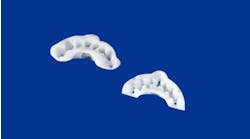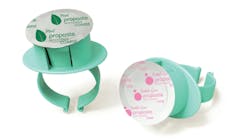Ask your patients to pack up the home-care products they use and bring them to the next appointment
by Lisa Stefanou, RDH, BS, MPH
Have you been stumped by a patient lately? It happens to the best of us. A patient mentions her new toothpaste, whitening system, or mouthwash. It is a brand or product you've never heard of. You might ask her if she knows the active ingredients, but the likelihood of a patient remembering a term like "polyglycol" is small. With a skyrocketing number of oral care products on store shelves, it's easy to see why some dental professionals might be concerned about how to keep up. Fortunately, many of these new products are not so difficult to figure out with the right tactics and tools.
For the past few years, many pharmacists have been implementing "brown bag" programs, in which they ask their patients to bring in all of their prescription and over-the-counter medications for a consultation. A study at Pennsylvania State University confirmed that this program was a better method of collecting patients' medication lists than the pharmacy record alone. Hygienists can take a cue from pharmacists and ask patients to bring all of their oral care products in during their next prophylaxis. The products you find (and don't find) in the bag will provide valuable insight into your patients' home care habits, and a good starting point for a discussion about the most appropriate products for each patient to use.
With your patient's products in front of you, you'll be able to personally review the labels for active ingredients. Maintaining familiarity with the most frequently used components will allow you to assess these products quickly. This article is intended as a quick reference for the most common ingredients you are likely to find. Given the limited scope of this article, it will detail only an abbreviated selection of the most common dentifrice ingredients. For more in-depth information on the wealth of other dentifrice additives, mouthrinses, and various oral products, the ADA Guide to Dental Therapeutics is a valuable tool for every practice, and can help you decipher the labels of those niche products that you may find unfamiliar.
A Toothpaste Refresher
You are likely familiar with the basic components of most dentifrices: detergents; abrasives; thickeners; humectants; preservatives; and sweetening, flavoring, and coloring agents. Depending on a toothpaste's intended function, one or more ingredients may be added to prevent caries, reduce gingivitis, treat dentin hypersensitivity, or whiten teeth. When you examine products in your patient"s bag, it's these active ingredients that should be your primary focus.
• Cavity prevention: Nearly every variety of toothpaste found on store shelves today employs some form of fluoride to prevent caries. Stannous fluoride was the original form to be incorporated into dentifrices in the 1960s, but when issues surfaced regarding its shelf life, it was largely phased out and substituted with sodium monofluorophosphate and sodium fluoride, both of which are still used today. A stabilized form of stannous fluoride is sometimes still employed, but hygienists may wish to caution patients that it has been found to cause yellowing of the teeth.
• Gingivitis reduction: Triclosan is the most popular and effective ingredient for the reduction or prevention of gingivitis. It has also been shown to be effective against plaque and calculus. But to be most effective, triclosan must be delivered with polyvinyl methyl ether and maleic acid, which help the substance stay in the oral cavity longer. The combination is often labeled as "PVM/MA copolymer."
• Hypersensitivity treatment: One condition that makes it important to look for what isn't in your patient"s bag is dentin hypersensitivity. This condition has been estimated to affect one in five people, yet more than 40 percent of sufferers don't mention the problem to their dental professionals, and many may not have implemented an OTC treatment. Using a dentifrice with 5 percent potassium nitrate, such as Sensodyne (GlaxoSmithKline Consumer Healthcare), can be a simple method of addressing this issue. Potassium nitrate works by depolarizing nerve endings in the teeth to prevent transmission of pain signals. It is worthwhile to ask patients, especially those in the high-risk category — women aged 20 to 30 — if they ever experience sensitivity. An affirmative answer is your opening for a discussion of causes and treatment options.
If you find that your patient is already using a potassium nitrate toothpaste, then you can inquire about sensitivity triggers and, if necessary, bring the issue to the dentist's attention. As you may know, the FDA requires sensitivity toothpastes to carry a statement cautioning against use for more than four weeks, but once a dentist rules out any serious underlying cause of sensitivity, patients are safe to use a desensitizing dentifrice as long as they wish.
Other ingredients that can reduce sensitivity include strontium chloride, which was once common, but has largely been supplanted by potassium nitrate, which provides a more pleasant taste and feeling in the mouth. However, strontium chloride toothpastes can still be found in other countries.
• Whitening agents: Whitening toothpastes use abrasives and enzymes to remove extrinsic stains from teeth. Hydrated silica, sodium tripolyphosphate, and tetrasodium pyrophosphate are frequently used for stain removal. This mechanism of action is not to be confused with that of other home whitening products like bleaching strips or bleaching trays, which use hydrogen peroxide or carbamide peroxide to brighten the tooth appearance from a deeper level.
A Glimpse Into Hygiene Habits
By examining patients" brown bags, you'll be afforded a revealing glimpse into their hygiene habits. This insight can help you ask your patients the right questions, and may even alert you to opportunities that might otherwise go unnoticed. A brown bag with whitening toothpaste, whitening mouthwash, home bleaching strips, and whitening floss is a natural reason to bring up in-office whitening options, and also to inquire if your patient is suffering from whitening-related sensitivity. A brown bag containing a mouthwash approved for cosmetic use only is an opportunity to suggest a more effective variety to a patient with calculus buildup.
Consumers today are reaping the benefits of decades of dental research, and many are relieved to learn that the right OTC products can be enough to treat many oral health problems. It is finding those products that can be an overwhelming task for the typical patient. Your expert product recommendations and reviews can help solidify your personal relationship with patients and build your hygiene practice. Additionally, the daily examinations of your patients' products will keep you up-to-date with what is available, and over time, you"ll become even harder to stump.
About the Author
Lisa Stefanou, RDH, BS, MPH, is assistant director of Dental Hygiene Programs and associate professor at New York University College of Dentistry, New York. She practices clinical dental hygiene and especially enjoys working with pediatric patients. In addition to her teaching and clinical work, she has contributed to dental hygiene textbooks.







